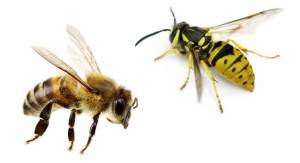 Every year social media groups and communities I am on light up with “I think I have a swarm of bees, can anyone help”? My initial instinct is always, yes! Many beekeepers are all about capturing swarm (some are even proactive, using swarm traps and bait hives, but more on that another time). However, after a lot “false positives” I’ve tried to make a reference document for folks to help make it easier to figure out what they may be dealing with.
Every year social media groups and communities I am on light up with “I think I have a swarm of bees, can anyone help”? My initial instinct is always, yes! Many beekeepers are all about capturing swarm (some are even proactive, using swarm traps and bait hives, but more on that another time). However, after a lot “false positives” I’ve tried to make a reference document for folks to help make it easier to figure out what they may be dealing with.
Are These Honey Bees?
While honey bees are one of the most social of the flying insects that look “bee like”, there are others that appear in large enough numbers to fool the untrained eye. Here are a couple quick reference points that can help:
- Honey bees tend to have a barrel shaped body, without the narrow waist seen in wasps and hornets
- Honey bees have tiny hairs over the majority of their bodies. This gives them a fuzzy look unlike most wasps and hornets with are typically shiny and smooth, with a few spiky hair-like structures
- Honey bees will tend to flit from flower to flower, while most wasps and hornets often appear to patrol or scan an area for prey.
- Hornets and wasps tend to be more aggressive in general. While bees will “bump” and pursue people and animals near their hives, when they are out foraging, they tend to be oblivious and non-confrontational, as long as they are not directly assaulted.
- Honey bees rarely nest in the ground (though it may appear so, if there is a log or other structure with a ground level entrance).
- Honey bee hives do not have paper structures hanging from trees or other structures, though you may see a honey bee swarm temporarily taking shelter out in the open.
Capture or More Complicated?
Even if what you have encountered are honey bees, it may not be as simple as having a beekeeper scoop them up and drive off. The most common scenarios are the classic “swarm” and an established hive.
Swarm Captures are pretty easy since the bees in question are out looking for a new home, receptive to being introduced to a potential home and generally much more docile. If you’ve never seen a true swarm of bees, it can be easy to confuse any large number of bee-like insects for a swarm. Some key points of a swarm:
- A large, dense and opaque mass of bees, as small as a football, but sometimes much larger.
- Deep inside this mass the queen is typically resting, while scout bees are surveying the area, looking for likely sites for establishing a new hive.
- The swarm will tend to move on, either to expand their search or to move in to a permanent hive location. This can occur in a matter of just a few hours or a couple days.
Extraction/Cutout is the removal of a settled or established hive. This can be much harder since established bees will typically defend their hive, and the process can involve physical demolition of a structure and a lot of subsequent cleanup and repair. Many beekeepers are unwilling or unequipped for this sort of capture.
- Comparatively small numbers of bees coming or going, sometimes with pollen on their legs.
- Bees are more aggressive in defending the area
- Number of bees increases and decreases over the seasons
- Sometimes honey or wax can be seen or smelled in the area
- Visible “comb” or other structures have been built (attics, sheds, etc)